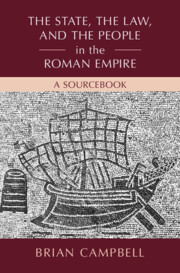Refine search
Actions for selected content:
1165 results
3 - Fact finding
-
- Book:
- The Art of Legal Problem Solving
- Published online:
- 11 March 2024
- Print publication:
- 01 May 2027, pp 24-41
-
- Chapter
- Export citation
1 - Introduction
-
- Book:
- The Art of Legal Problem Solving
- Published online:
- 11 March 2024
- Print publication:
- 01 May 2027, pp 1-6
-
- Chapter
- Export citation
7 - Writing it up
-
- Book:
- The Art of Legal Problem Solving
- Published online:
- 11 March 2024
- Print publication:
- 01 May 2027, pp 97-102
-
- Chapter
- Export citation
6 - Putting it all together
-
- Book:
- The Art of Legal Problem Solving
- Published online:
- 11 March 2024
- Print publication:
- 01 May 2027, pp 68-96
-
- Chapter
- Export citation
5 - Analysing a problem
-
- Book:
- The Art of Legal Problem Solving
- Published online:
- 11 March 2024
- Print publication:
- 01 May 2027, pp 55-67
-
- Chapter
- Export citation
4 - Statutory interpretation and the criminal law
-
- Book:
- The Art of Legal Problem Solving
- Published online:
- 11 March 2024
- Print publication:
- 01 May 2027, pp 42-54
-
- Chapter
- Export citation
2 - Fundamentals of problem solving
-
- Book:
- The Art of Legal Problem Solving
- Published online:
- 11 March 2024
- Print publication:
- 01 May 2027, pp 7-23
-
- Chapter
- Export citation
1 - Solidarity and Law
-
-
- Book:
- The Question of Solidarity in Law and Politics
- Published online:
- 22 December 2025
- Print publication:
- 29 January 2026, pp 11-29
-
- Chapter
-
- You have access
- Open access
- HTML
- Export citation
Chapter 3 - Kant on the General Will Test and the Categorical Imperative Procedure
- from Part I - Law and Morality: Derivation or Separation?
-
-
- Book:
- Law and Morality in Kant
- Published online:
- 16 December 2025
- Print publication:
- 22 January 2026, pp 54-74
-
- Chapter
-
- You have access
- Open access
- HTML
- Export citation
Chapter 13 - Independence and Kant’s Positive Conception of Freedom
- from Part V - Law and Morality in Kant’s Political Theory
-
-
- Book:
- Law and Morality in Kant
- Published online:
- 16 December 2025
- Print publication:
- 22 January 2026, pp 262-284
-
- Chapter
-
- You have access
- Open access
- HTML
- Export citation
Chapter 3 - Truth, Falsity, and the Capacity to Judge
-
-
- Book:
- The Aristotelian Kant
- Published online:
- 15 December 2025
- Print publication:
- 22 January 2026, pp 65-91
-
- Chapter
- Export citation
8 - Dementia, Equality, and the Law of the United Kingdom
-
- Book:
- Relating to People Living with Dementia as Equals
- Published online:
- 12 December 2025
- Print publication:
- 22 January 2026, pp 152-167
-
- Chapter
- Export citation
Chapter 14 - Political Theory
- from Part III - Political Science
-
- Book:
- The Ladder of the Sciences in Late Antique Platonism
- Published online:
- 08 December 2025
- Print publication:
- 08 January 2026, pp 195-209
-
- Chapter
- Export citation
Chapter 19 - Law and Legislator in the Philosophy of Julian the Emperor
- from Part III - Political Science
-
- Book:
- The Ladder of the Sciences in Late Antique Platonism
- Published online:
- 08 December 2025
- Print publication:
- 08 January 2026, pp 253-263
-
- Chapter
- Export citation
Chapter 20 - Plato’s Tyrant in Neoplatonic Philosophy
- from Part III - Political Science
-
- Book:
- The Ladder of the Sciences in Late Antique Platonism
- Published online:
- 08 December 2025
- Print publication:
- 08 January 2026, pp 264-274
-
- Chapter
- Export citation
Judicial Professional Background and Pretrial Detention Outcomes
-
- Journal:
- Journal of Law and Courts ,
- Published online by Cambridge University Press:
- 18 December 2025, pp. 1-24
-
- Article
- Export citation
18 - A Private-Sector Perspective on the Sanctions–Industrial Complex
- from Part II - Legality, Legitimacy, and Accountability
-
-
- Book:
- Economic Sanctions from Havana to Baghdad
- Published online:
- 28 November 2025
- Print publication:
- 18 December 2025, pp 384-416
-
- Chapter
-
- You have access
- Open access
- HTML
- Export citation
Introduction
-
- Book:
- Empires of Labor
- Published online:
- 30 November 2025
- Print publication:
- 18 December 2025, pp 1-34
-
- Chapter
-
- You have access
- HTML
- Export citation

The State, the Law, and the People in the Roman Empire
- A Sourcebook
-
- Published online:
- 11 December 2025
- Print publication:
- 11 December 2025
Introduction
-
- Book:
- The State, the Law, and the People in the Roman Empire
- Published online:
- 11 December 2025
- Print publication:
- 11 December 2025, pp 1-13
-
- Chapter
-
- You have access
- HTML
- Export citation
